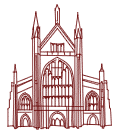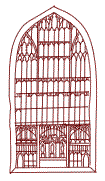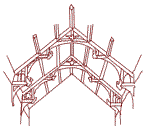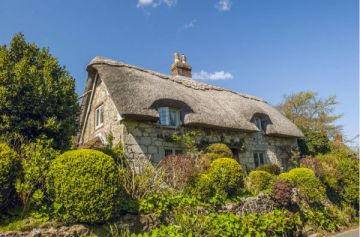The style we know as Perpendicular Gothic is the final phase of Gothic architecture in England, after the Early English and Decorated periods, and it lasted by far the longest of the three periods, stretching from the late 14th until the early 16th century.

cathedral
As its name suggests, the chief characteristic of Perpendicular architecture is the emphasis on strong vertical lines, seen most markedly in window tracery and wall panelling. Roof vaulting became elaborate and ornate, with a multitude of vaulting ribs spreading outwards in a fan shape, ornamented with pendants and cross-ribs that served a purely decorative function.
Perhaps the finest examples of Perpendicular fan vaulting survive at King's College Chapel, Cambridge (1446-1515), and Henry VII's Chapel at Westminster Abbey (1503-1519).

The flying buttress reached its final graceful and highly decorated form, with knobs, crockets and small pinnacles adorning every possible surface.
Windows were the "artist's palette" of the Perpendicular builders; because of advances in the use of the pointed arch and supporting elements such as the flying buttress, window openings could be extremely large, and builders took advantage of their opportunity to create huge expanses of glass separated by thin, curving stone tracery in ever more elaborate patterns.
Window area was maximised, while wall area was minimised. The result is lofty, open interiors of extraordinary lightness and delicacy.
Another notable characteristic of Perpendicular Gothic is hammerbeam roofs, where advances in joinery and a better understanding of how to distribute the load and thrust of ceiling weight allowed roofs which spanned great open spaces.
The hammerbeam roof is the wooden equivalent of the stone vaulting used in the great cathedrals of the time. Simply put, hammerbeam construction makes use of short horizontal and vertical beams to distribute the weight of a roof. These short beams rise in steps from the top of a wall to the roof peak, creating a more open space than earlier techniques allowed.

Although the timbers which made up the supporting elements in hammerbeam roofs were structural, they were also used as ornamental elements. The meeting places of timbers were often adorned with pendants or fanciful carvings, and the timbers themselves were often painted and gilded. The best examples of hammerbeam roofs are to be found in East Anglia, particularly the churches of Norfolk.
Hood moulding over doors was squared off, rather than echoing the pointed arch opening of the door itself. Piers were still constructed of clusters of thin shafts, as in the Decorated period, but the separation between the shafts was not so pronounced; the separate shafts becoming more like simple folds of stone on the surface of the pier.
The curvilinear carving which so characterized the Decorated period became more formal, less flowing. Foliage designs were still the most popular motif, but even these are more stiff and formal, less ebullient, and certainly less natural. Carvings are shallower and stand out very little from the surface of their stone background.
Perpendicular Gothic at a glance ~ Late 14th - early 16th century
~ Strong vertical lines
~ Very large windows with elaborate tracery
~ Fan vaulting
~ Hammerbeam roofs
Major Perpendicular Gothic buildings to visit:
Westminster Hall, London
King's College Chapel, Cambridge
Henry VII's Chapel at Westminster Abbey, London
Bath Abbey
Winchester Cathedral nave
Related:
Gothic architecture
article © David Ross and Britain Express
Illustrations are based on those in the wonderful volume 'The Observer's Book of British Architecture', by John Penoyre & Michael Ryan, London, 1951



